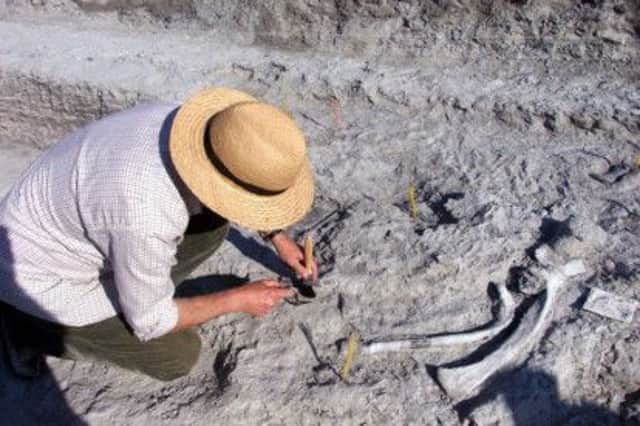Secrets of evolution lie beneath Scotland’s soil


At the end of August, a group of 140 palaeontologists from around the world gathered in Edinburgh to discuss their research, ranging from dinosaur feeding behaviour to pterosaur flight and the world’s largest bony fish – the latter being the outcome of research supported by Glasgow University and National Museums Scotland.
As part of the gathering – the 61st Symposium of Vertebrate Palaeontology and Comparative Anatomy – a special session was convened honouring the work of Stan Wood, one of Scotland’s most talented field palaeontologists.
Advertisement
Hide AdAdvertisement
Hide AdThroughout his life, Stan showed that some of the world’s most important fossils could be found right here in Scotland. His excavations in Bearsden yielded remarkable 330 million-year-old sharks and at East Kirkton he discovered the famed “Lizzie”, one of the world’s oldest reptiles and now one of the treasures on display at the National Museum of Scotland. But now an even greater find is exciting the world’s palaeontological community.
There are a number of big questions in palaeontology, such as where and under what conditions did life first evolve; what caused the extinction of the dinosaurs; and what were the detailed steps in our own evolution? But one question has stood out for many years as a mystery: what did the earliest vertebrates (animals with backbones) look like, and under what conditions did they emerge on wto land?
Without those first steps on land, the whole array of vertebrate life that we see today, including ourselves, could not have evolved.
We know the transition to land occurred around 345-360 million years ago but, despite global searches for vertebrates from this period, only one or two fragmentary remains were discovered. Where were the fossils that would answer our questions?
This question puzzled a Harvard professor, Alfred Sherwood Romer, one of the most renowned vertebrate palaeontologists of recent times. He spent a part of his career looking for fossils from this time period, without success. The period came to be known as Romer’s Gap and it was even suggested that very few forms made it on to land during this interval.
To Stan, this merely represented a problem which he set out to resolve.
His characteristic vigour and determination eventually paid off with the discovery of a stunning cache of fossils from a site near Chirnside in the Borders.
Specimens found to date include plants, fish and amphibians, including an early amphibian which Stan christened “Ribbo” due to its prominent and well-preserved vertebrate structure. This has provided us with enough information to interpret what the creature may have looked like as it roamed the Tweed basin around 350 million years ago.
Advertisement
Hide AdAdvertisement
Hide AdThe importance of the find cannot be underestimated and it has formed the focus of a major research initiative funded by the Natural Environment Research Council and Heritage Lottery Fund.
The fossils have been acquired by National Museums Scotland, which has teamed up with the British Geological Survey and the universities of Cambridge, Southampton and Leicester to not only study Stan’s finds, but also to continue the search for more fossils in the Tweed basin and to better understand Scotland’s environment at the time.
To date, a key part of the study has involved the drilling of a 500-metre borehole. This will form the anchor stone for the team to date all of the fossil finds and hopefully piece together the story of how vertebrates colonized land.
This is a significant part of our natural heritage and the research team has made a strong commitment to bring the science to the widest possible audience.
Delegates at the symposium heard how the careers of professors Mike Coates from the University of Chicago and John Long from Flinders University were shaped and influenced by Stan’s discoveries and encouragement.
Details of how Romer’s Gap is now being filled featured strongly, with Professor Jenny Clack and Dr Tim Smithson of the University of Cambridge, providing first insights into these tantalising new fossils.
Stan sadly died last year, but his legacy lives on, in some respects echoing that of Edinburgh’s James Hutton, the father of modern geology, who established the importance of Scotland as a place for students of the earth sciences.
There is no doubt that Stan’s discoveries will continue to shape the careers of such students for generations to come.
• Dr Nick Fraser is Keeper of Natural Sciences, National Museums of Scotland www.nms.ac.uk